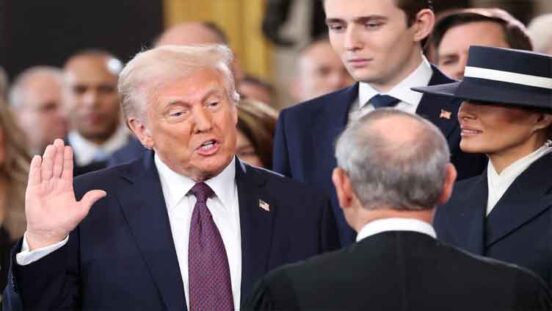By Qamar Bashir
In a stunning policy shift that has sent shockwaves through the education sector,
President Donald J. Trump has dismantled the U.S. Department of Education. Framing
the move as an overdue return of control to the states, Trump described it as a step toward
“freedom of choice,” empowering families and communities to decide what’s best for
their children’s education without interference from Washington.
The now-defunct Department, which oversaw national education standards, civil rights
protections, and billions in federal funding, has been stripped of its authority. In its place,
states are being asked to take full ownership of their education systems—designing their
own curricula, setting standards, managing teacher certification, and overseeing
accountability.
While advocates of decentralization celebrate this as a chance to innovate, critics warn
that it is a recipe for chaos. Wealthier states with robust education infrastructure may
thrive under local control, continuing to produce competitive students. But under-
resourced states—especially in the South and rural Midwest—may struggle to sustain
even basic levels of quality without federal funding or guidance. The result could be an
educational patchwork where opportunity and excellence depend not on merit, but on
geography.
The immediate fallout includes the layoff of over 4,400 federal employees and the
withdrawal of more than $82 billion in federal funding that supported everything from
early education to college access. Among the most affected are programs like Title I
Grants, which provided over $16 billion annually to schools serving low-income
communities, and Pell Grants, which enabled well over 7 million students from working-
class families to attend college. Federal assistance for children with disabilities under
IDEA, school meal programs, and support for English language learners and STEM
education have also been impacted.
These programs once served as lifelines to marginalized and disadvantaged communities.
With their funding now uncertain and their management delegated to state governments,
the concern is that racial and socioeconomic gaps will widen. Families with
means—predominantly white and affluent—can pivot to well-funded private schools and
benefit from increased local investment. But millions of low-income students may be left
behind, attending increasingly under-resourced public schools with shrinking support
systems.
Many experts fear that a two-tier education system is emerging, one that privileges the
rich while further marginalizing the poor. In such a system, the quality of a child’s
education will depend more than ever on ZIP code, race, and economic status. Over time,
this could entrench inequality and fuel societal divisions.
At the same time, Trump’s move raises concerns about the rise of private influence. As
state budgets tighten and federal support fades, education may become increasingly
dependent on private foundations, corporate partnerships, and philanthropic donors.
While this could open doors for innovation, it also risks allowing private interests to
shape public education according to market demands rather than democratic values.
There is a growing worry that public schools may become politically sidelined and
financially starved while elite private institutions thrive.
Trump’s decision is not without precedent or rationale. For years, critics have argued that
the Department of Education had grown bloated, inefficient, and overbearing—more
focused on compliance and paperwork than actual outcomes. They say returning control
to local authorities can foster accountability, responsiveness, and creativity in tackling
challenges specific to each region.
But the scale and speed of the change have left little time for adaptation. Education is not
a short-term enterprise. It is a long-term investment whose results unfold over
generations. A shift this drastic, without a safety net or transition plan, risks undermining
the very students it seeks to empower.
To better understand the potential consequences, it’s important to recall how the federal
role in education evolved. For much of U.S. history, education was left to states and local
school districts. But this decentralized approach produced huge inequalities—between
urban and rural districts, between the North and South, and especially between white and
Black communities.
The federal government stepped in gradually but decisively. The GI Bill in 1944 opened
college doors to returning veterans. The landmark Brown v. Board of Education ruling in
1954 declared school segregation unconstitutional. In 1965, the Elementary and
Secondary Education Act brought large-scale federal funding to disadvantaged districts
as part of President Lyndon B. Johnson’s War on Poverty. The Individuals with
Disabilities Education Act in 1975 ensured that children with disabilities had equal access
to public education. Finally, in 1979, the Department of Education was created under
President Jimmy Carter to centralize these efforts and ensure consistent national
standards.
Since then, federal oversight has helped enforce civil rights, improve data collection,
expand access to higher education, and provide targeted funding to the schools and
students who need it most. Dismantling this legacy means reverting to a pre-1960s
model—a time when disparities in access and quality went largely unaddressed.
Whether Trump’s bold restructuring will yield success remains to be seen. Supporters
believe it will lead to innovation and efficiency, but critics argue it will exacerbate
inequality and undercut the nation’s competitiveness. If the next four years do not
produce measurable improvements, the political winds could shift. A future Democratic
administration, or a new Republican president, could potentially restore the Department
and reinstate federal programs. But undoing such a sweeping reform will take time—and
by then, state systems may have fully adapted to a decentralized model.
What is certain is that this decision represents a defining moment in American education.
It challenges long-held assumptions about the role of government, the purpose of public
schools, and the meaning of equal opportunity. It forces the nation to ask: Should
education be a shared national priority—or a local experiment shaped by wealth, race,
and regional politics?
Trump’s education revolution is underway. Whether it becomes a model for the future or
a cautionary tale remains an open question.




